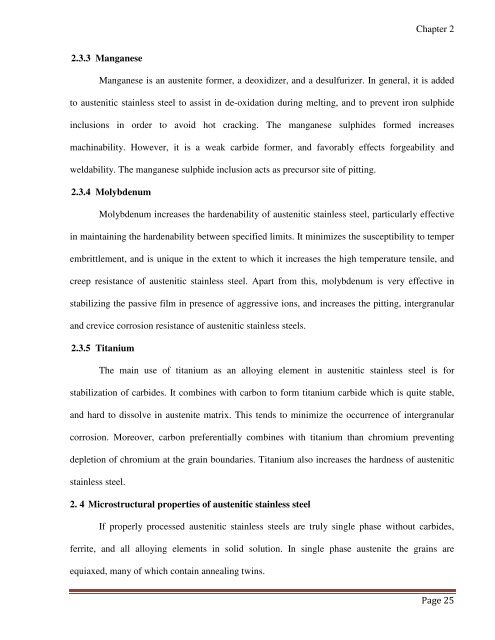CHEM02200704003 Nilamadhab Pandhy - Homi Bhabha National ...
CHEM02200704003 Nilamadhab Pandhy - Homi Bhabha National ...
CHEM02200704003 Nilamadhab Pandhy - Homi Bhabha National ...
Create successful ePaper yourself
Turn your PDF publications into a flip-book with our unique Google optimized e-Paper software.
Chapter 2<br />
2.3.3 Manganese<br />
Manganese is an austenite former, a deoxidizer, and a desulfurizer. In general, it is added<br />
to austenitic stainless steel to assist in de-oxidation during melting, and to prevent iron sulphide<br />
inclusions in order to avoid hot cracking. The manganese sulphides formed increases<br />
machinability. However, it is a weak carbide former, and favorably effects forgeability and<br />
weldability. The manganese sulphide inclusion acts as precursor site of pitting.<br />
2.3.4 Molybdenum<br />
Molybdenum increases the hardenability of austenitic stainless steel, particularly effective<br />
in maintaining the hardenability between specified limits. It minimizes the susceptibility to temper<br />
embrittlement, and is unique in the extent to which it increases the high temperature tensile, and<br />
creep resistance of austenitic stainless steel. Apart from this, molybdenum is very effective in<br />
stabilizing the passive film in presence of aggressive ions, and increases the pitting, intergranular<br />
and crevice corrosion resistance of austenitic stainless steels.<br />
2.3.5 Titanium<br />
The main use of titanium as an alloying element in austenitic stainless steel is for<br />
stabilization of carbides. It combines with carbon to form titanium carbide which is quite stable,<br />
and hard to dissolve in austenite matrix. This tends to minimize the occurrence of intergranular<br />
corrosion. Moreover, carbon preferentially combines with titanium than chromium preventing<br />
depletion of chromium at the grain boundaries. Titanium also increases the hardness of austenitic<br />
stainless steel.<br />
2. 4 Microstructural properties of austenitic stainless steel<br />
If properly processed austenitic stainless steels are truly single phase without carbides,<br />
ferrite, and all alloying elements in solid solution. In single phase austenite the grains are<br />
equiaxed, many of which contain annealing twins.
















